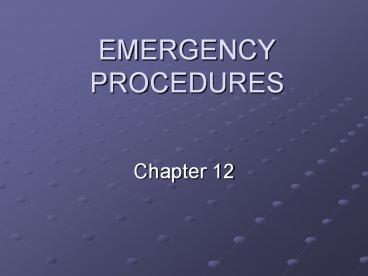EMERGENCY PROCEDURES PowerPoint PPT Presentation
Title: EMERGENCY PROCEDURES
1
EMERGENCY PROCEDURES
- Chapter 12
2
Prompt Care is Essential
- Knowledge of what to do
- Knowledge of how to do it
- Being prepared to follow through
- There is no room for uncertainty
- There is no room for error
3
The Emergency Plan
- The key to emergency aid in the sports setting is
the initial evaluation of the injured athlete. - The prime concern is to maintain cardiovascular
function (ABCs) and central nervous system
function.
4
The Emergency Plan
- EMS communication
- Telephones must be available
- Designate someone to call 911
- The right information must be communicated
- Type of emergency situation
- Type of suspected injury
- Present condition of the athlete
- Current assistance being given
- Location of telephone being used and location
- Exact location of the emergency
5
The Emergency Plan
- Emergency Action Plan
- Transportation policies
- Treatment policies
- Keys to the appropriate gates
- Separate emergency plans should be developed for
each sports field, court etc. - Cooperation with emergency care providers
- Parent notification
6
Principles of On-The-Field Injury Assessment
- Primary Survey determines the existence of
potentially life-threatening situations. - Airway
- Breathing
- Circulation
- Severe bleeding
- Shock
7
Principles of On-The-Field Injury Assessment
- Secondary Survey systematically assesses vital
signs and symptoms for a more detailed evaluation
of the injury. - Observation
- History
- Inspection
- Palpation
- Range of motion
- Special tests
8
Secondary Survey Recognizing the Vital Signs
- Pulse should be taken at the carotid artery or
the radial artery with two fingers. - Adult resting pulse 60-80
- Child resting pulse 80-100
- Rapid and weak shock, bleeding, diabetic
coma, or heat exhaustion - Rapid and strong heat stroke
- Slow and strong skull fracture or stroke
- No pulse cardiac arrest or death
9
Secondary Survey Recognizing the Vital Signs
- Respiration check airway and breathing
- Look
- Listen
- Feel
- Normal adult respirations 12 a minute
- Normal child respirations 20 a minute
- Shallow respirations shock
- Gasping respirations cardiac involvement
- Frothy blood in the mouth lung injury
10
Secondary Survey Recognizing the Vital Signs
- Blood Pressure force of the blood against the
arterial walls measured by a sphygmomanometer and
stethascope. - Systolic / Diastolic
- Adult males 120 / 80
- Adult females 110 / 70
- High blood pressure cardiac involvement
- Low blood pressure hemorrhage, shock, heart
attack or internal organ injury
11
Secondary Survey Recognizing the Vital Signs
- Temperature is measured by a thermometer under
the tongue, armpit, or rectum but skin also
reflects temperature. - Normal core temperature 98.6
- Hot dry skin disease, infection, heat stroke
- Cool clammy skin shock, heat exhaustion
- Cool dry skin over exposure to cold
12
Secondary Survey Recognizing the Vital Signs
- Skin color can quickly be used to identigy
medical emergencies. - Red skin heatstroke, high blood pressure
- Pale skin insufficient circulation, shock,
hemorrage, heat exhaustion, or insulin shock - Blue skin poorly oxygenated blood (airway
obstruction or respiratory failure) - Dark skin look at lips, mouth or nails
13
Secondary Survey Recognizing the Vital Signs
- Pupils are very sensitive to injury affecting
the nervous system. - Constricted depressant drug
- Dilated head injury, shock, heat stroke,
hemorrhage, stimulant drug - Failed response to light head injury, alcohol
or drug poisoning
14
Secondary Survey Recognizing the Vital Signs
- State of Consciousness awareness
- Normal (quickly responds to stimuli) alert
- Unconscious (does not respond to stimuli) 3rd
degree concussion - Groggy (responds slowly to stimuli) 2nd
degree concussion - Conscious (full memory but responds slowly to
stimuli) 1st degree concussion
15
Secondary Survey Recognizing the Vital Signs
- The Unconscious Athlete
- Check the ABCs
- Check for milky fluid from the ears or nose
- Check for bumps, lacerations or deformity
- NEVER move an unconscious athlete
- NEVER remove the helmet
16
Secondary Survey Recognizing the Vital Signs
- Nervous System
- Check movement of extremities
- Lack of movement head or neck injury
- Check sensation of body areas
- Numbness nerve injury
- Lack of pain shock or spinal cord injury
17
Response to The Primary Survey
- Obstructed airway management
- Rescue breathing
- CPR / AED
- Stop severe bleeding
- Treat for shock
- Stabilize the athlete until EMS arrives
18
Response to The Secondary Survey
- Determine the seriousness of the injury
- Determine the type of first aid necessary
- Determine if referral is warranted
- Determine where referral is warranted
- Determine the manner of transportation
- Determine the immediate treatment
19
Immediate Treatment
- Bandaging
- Splinting
- Metal splints
- Vacuum splints
- Anatomical splints
- Others
- Immediate Transportation
- Ambulatory aid
- Manual conveyance
- Stretcher / spine board
- RICES

